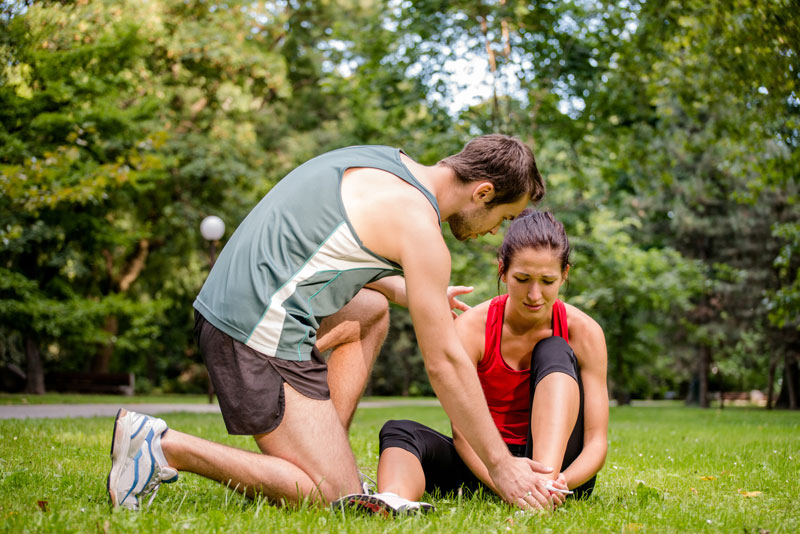Workouts and exercise provides great health benefits, but also come with risk of injuries, strains and sprains. Most common causes of workout injuries include poor posture, exercising before warming up body, repetitive motion, not taking enough rest between workouts, performing too strenuous exercise, improperly using proper equipment, twisting or pushing your body too hard. Physicians can rely on orthopedics medical coding services to report diagnoses and treatments, and ensure accurate claims submission.
ICD-10 Codes for Common Workout Injuries
Bicep tendon rupture
A biceps tendon tear can occur either at the shoulder or the elbow. Heavy weight lifting can stress on the biceps and cause the tendon to tear away from the bone, and even separation of the muscles from the bone.
- M66.82 Spontaneous rupture of other tendons, upper arm
- M66.821 Spontaneous rupture of other tendons, right upper arm
- M66.822 Spontaneous rupture of other tendons, left upper arm
- M66.829 Spontaneous rupture of other tendons, unspecified upper arm
Labral tear
Hip labral tear is mainly caused by exercises, sports-related activities or other physical activities which involve sudden twisting or long-distance running that can lead to joint wear or tear.
- S43.43 Superior glenoid labrum lesion
- S43.431 Superior glenoid labrum lesion of right shoulder
- S43.432 Superior glenoid labrum lesion of left shoulder
- S43.439 Superior glenoid labrum lesion of unspecified shoulder
Sternum fracture
The sternum protects the heart, lungs, and other major blood vessels. Pain in the sternum can occur during exercise or as a result of a variety of conditions or injuries. Sternum fractures usually occur as a direct result of trauma. Major symptoms include difficulty breathing, pain and swelling over the sternum.
- S22.2 Fracture of sternum
- S22.20 Unspecified fracture of sternum
- S22.20XA …… initial encounter for closed fracture
- S22.20XB …… initial encounter for open fracture
- S22.20XD …… subsequent encounter for fracture with routine healing
- S22.20XG …… subsequent encounter for fracture with delayed healing
- S22.20XK …… subsequent encounter for fracture with nonunion
- S22.20XS …… sequela
- S22.20 Unspecified fracture of sternum
Low back pain
Strenuous workouts or heavy weight lifting can put strain on the muscles surrounding the spine, causing low back pain.
- M54.50 Low back pain, unspecified
- M54.51 Vertebrogenic low back pain
- M54.59 Other low back pain
Pectoralis injury
Pectoralis injury refers to a tear in the large muscle which covers the chest. Pectoralis major strain may occur during weight training or bench press exercises when the muscle is forcibly contracted whilst in a stretched position.
- S29.011A Strain of muscle and tendon of front wall of thorax, initial encounter
- Y92.39 Other specified sports and athletic area as the place of occurrence of the external cause
- Y93.B9 Activity, other involving muscle strengthening exercises
Knee injuries
Physical activities like running, jumping, stretching and bending can put a lot of strain on the knees, causing pain. Runner’s knee is a common injury caused by frequent bending of the knees during high-stress exercises.
- S83 Dislocation and sprain of joints and ligaments of knee
- S83.0 Subluxation and dislocation of patella
- S83.1 Subluxation and dislocation of knee
- S83.2 Tear of meniscus, current injury
- S83.3 Tear of articular cartilage of knee, current
- S83.4 Sprain of collateral ligament of knee
- S83.5 Sprain of cruciate ligament of knee
- S83.6 Sprain of the superior tibiofibular joint and ligament
- S83.8 Sprain of other specified parts of knee
- S83.9 Sprain of unspecified site of knee
Shin splint
Shin splint refers to the pain in the inner edge of the tibia or shinbone. Also referred to as medial tibial stress syndrome, the condition develops when the muscle and bone tissue in the leg become overworked by repetitive motions.
- M76.81 Anterior tibial syndrome
- M76.811 …… right leg
- M76.812 …… left leg
- M76.819 …… unspecified leg
Tendinitis
Common among body builders, this condition is when the repetitive motion of lifting puts the tendon under strain and causes tightening over time. Also referred to as overuse tendinopathy, the condition can lead to rotator cuff tendinitis of the shoulder, and lateral epicondylitis, or tennis elbow.
- M77.1 Lateral epicondylitis
- M76.6 Achilles tendinitis
- M76.60 Achilles tendinitis, unspecified leg
- M76.61 Achilles tendinitis, right leg
- M76.62 Achilles tendinitis, left leg
- M75.1 Rotator cuff tear or rupture, not specified as traumatic
Hernia
Physical activities such as lifting heavy weights can result in hernias due to increased pressure within the abdominal cavity. The condition usually occurs when correct lifting techniques are not followed.
- K40 Inguinal hernia
- K41 Femoral hernia
- K42 Umbilical hernia
- K43 Ventral hernia
- K44 Diaphragmatic hernia
- K45 Other abdominal hernia
- K46 Unspecified abdominal hernia
Workout injuries are the result of repetitive and forceful motions. Treatment for workout injuries depends on the severity of the symptoms. Medications such as non-steroidal anti-inflammatory drugs such as ibuprofen and naproxen sodium are usually recommended to relieve pain and reduce inflammation. Corticosteroid injections are administered as a temporary solution to control the joint pain. Physical therapy programs help maximize hip range of motion and hip and core strength and stability. Surgery will be recommended only if conservative treatments don’t relieve symptoms.
Orthopedics is an extensive area and reporting diagnosis and treatments for various conditions can be complex. Expert orthopedic medical coding services can help physicians ensure accurate claims submission with the right codes and adherence to payer guidelines.




